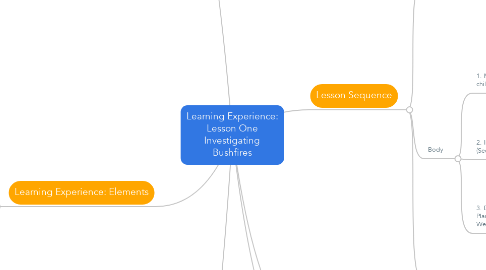
1. Lesson Sequence
1.1. Introduction
1.1.1. 1. Engage children in a whole-class discussion about Bushfires. Refer to focus questions.
1.1.2. 2. Explore and give examples of the various types of Bushfires that occur.
1.1.2.1. Explain the main types of Bushfires:
1.1.2.1.1. Spot Fires (ember attack)
1.1.2.1.2. Crown Fires
1.1.2.1.3. Surface Fires
1.1.2.1.4. Grass Fires
1.1.2.2. Use Link to display images of each type: http://bushfireawarness.weebly.com/types-of-bushfires.html
1.2. Body
1.2.1. 1. Model and introduce ‘Risk Factor’ activity to children. (See Appendix 5).
1.2.1.1. Children are to analyse the potential hazards on the house.
1.2.1.1.1. Children create suitable solutions to maintain and reduce the Bushfire risk.
1.2.1.2. Allow children working time to develop solutions. Supervise and monitor children’s working progress by moving around the classroom.
1.2.2. 2. Introduce the BYOFPH Project Assessment (See Appendix 1) to students.
1.2.2.1. Read out scenario, rubric and considerations.
1.2.2.2. Answer any queries students may have about the project and clarify any confusions children may have about expectations.
1.2.3. 3. Discuss and explain the BYOFPH Design Plan with class. Refer students to the Useful Websites section of the Assessment Overview.
1.2.3.1. Children use their iPads for research.
1.2.3.2. Write up some suggestions of key words to type into google on the whiteboard.
1.2.3.3. All design plans must be signed off by the teacher.
1.3. Conclusion
1.3.1. Ask some students to present and share their solutions to the class using reasoning to justify their risk-management suitability.
2. Learning
2.1. Prior Knowledge
2.1.1. Knowledge of Bushfire safety
2.1.2. Knowledge of Bushfire and Floods from media sources (newspapers, television, radio, media reports).
2.1.3. Previous exposure when planning for ‘Product-based’ assessments.
2.1.4. Aware of how bushfires spread, the types of Bushfires and give examples of common behaviours.
2.2. Taught Content
2.2.1. Children will learn about the types of Bushfires that occur in Australia, as well as, the behaviours of bushfires. Children will be introduced to their BYOFPH Assessment Overview.
2.2.2. Children will create and develop solutions to minimise potential Bushfire risk factors
2.2.3. Children will explore their ideas and compile research from sources to complete their BYOFPH design plan.
2.3. Specific Learning Goals
2.3.1. • Recognise and name at least one type of Bushfire and a significant behaviour of Bushfires.
2.3.2. • Create a design plan, exploring their ideas to implement decisions so that they meet the design brief.
2.3.3. • Form solutions that reduce the impact of bushfires.
3. Learning Experience: Elements
3.1. Materials
3.1.1. Build Your Own Fire Proof House - Assessment Overview
3.1.2. Build Your Own Fire Proof House - Design Plan
3.1.3. iPads (Internet Access)
3.1.4. Risk Factor - House Image
3.1.5. Whole-class Checklist
3.1.6. A4 Lined Paper
3.2. Focus Questions
3.2.1. What is a Bushfire?
3.2.2. What are some types of Bushfires?
3.2.3. What are some ways fire could spread? How?
3.2.4. What factors could contribute to Bushfires in the home?
3.2.5. How could you minimise the risk of a Bushfire in the home?
3.2.6. What are some easy solutions to minimising the risk?
3.3. Assessment
3.3.1. Informal Assessment
3.3.1.1. Checklist
3.3.2. Formal Assessment
3.3.2.1. Formative Assessment
3.3.2.1.1. Build Your Own Fire Proof House - Design Plan
3.3.2.2. Diagnostic Assessment
3.3.2.2.1. Risk Factors for Bushfires
3.4. Teaching and Learning Adjustments
3.4.1. Further scaffolding will be provided for those who are at a lower literacy level of learning, by explaining and providing explanations for featured subject-specific vocabulary mentioned in the Assessment Overview, as well as, the task.
3.4.2. Provide images of risk factor house and write up URL links and keywords on the whiteboard to assist those whom may have visual difficulty.
4. Year Level
4.1. 5
5. Australian Curriculum
5.1. Achievement Standard Links
5.1.1. Students record project plans
5.1.2. Suggest criteria, including sustainability considerations, and use these to evaluate their ideas and designed solutions.
5.1.3. Propose action in response to geographical challenge.
5.2. General Capabilities
5.2.1. Literacy
5.2.2. Critical and Creative Thinking
5.3. Curriculum Content Descriptors
5.3.1. Design and Technologies
5.3.1.1. Critique needs or opportunities for designing, and investigate materials, components, tools, equipment and processes to achieve intended designed solutions (ACTDEP024)
5.3.2. Humanities and Social Sciences - Geography
5.3.2.1. The impact of bushfires or floods on environments and communities, and how people can respond (ACHASSK114)
5.4. Cross Curricular Priorities
5.4.1. Sustainability
